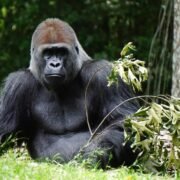Feathered Chronicles: A Journey into the Avian Wonders of Uganda’s Albertine Rift

Introduction:
Nestled in the heart of East Africa, the Albertine Rift, spanning across Uganda, Rwanda, and the Democratic Republic of Congo, is a biodiversity hotspot teeming with life. Among the myriad of species that call this region home, one avian gem stands out – Fox’s Weaver Bird. In this article, we will delve into the fascinating world of this unique bird species exclusive to Uganda and explore an additional 23 avian wonders that grace the Albertine Rift with their presence.
Endemic to Uganda, Fox’s Weaver Bird (Ploceus spekeoides) is a captivating and exclusive resident of the country’s southwestern region. Named after the British explorer and naturalist, Captain Francis Fox, who first documented the species in the late 19th century, this weaver bird boasts a distinctive appearance. Learn more
Characterized by its striking black and yellow plumage, the male Fox’s Weaver Bird sports a vibrant golden crown that sets it apart from its feathered counterparts. The female, on the other hand, exhibits more subdued colors, with a mottled brown appearance. Nestled among the dense vegetation, these intricate weaver birds construct elaborate nests suspended from branches, showcasing their exceptional weaving skills. Learn more
Habitat and Conservation:
Fox’s Weaver Bird thrives in the papyrus swamps and marshy areas around Lake Victoria. However, despite its unique charm, this avian species faces conservation challenges due to habitat loss and human encroachment. Efforts are being made to raise awareness and implement conservation measures to ensure the survival of this exclusive bird species. Learn more
Moving beyond Fox’s Weaver Bird, the Albertine Rift is a treasure trove of avian diversity, hosting a multitude of bird species that contribute to the region’s ecological richness. Here are 23 other remarkable birds that make the Albertine Rift their home: Learn more
Found in the montane forests of the Rwenzori Mountains, the Rwenzori Turaco captivates with its vibrant blue and green plumage. Its distinctive calls echo through the misty mountain landscapes, adding to the region’s enchanting ambiance. Learn more
This elusive bird, adorned with intricate black and white markings, inhabits the dense undergrowth of the Albertine Rift’s forests. The Handsome Francolin’s presence adds a touch of mystery to the lush vegetation it calls home. Learn more
Endemic to the Albertine Rift, the Kivu Ground Thrush enchants with its melodious song. With its subtle brown and white plumage, this ground thrush blends seamlessly into the forest floor, making it a challenging yet rewarding sighting for bird enthusiasts. Learn more
Resplendent in hues of iridescent green and purple, the Regal Sunbird graces the Albertine Rift’s flowering shrubs and woodlands. Its long, slender bill is adapted for sipping nectar from blossoms, contributing to the region’s intricate pollination network. Learn more
Known for its dazzling plumage and striking blue facial markings, the Congo Peafowl is an iconic bird species of the Albertine Rift. This elusive ground-dwelling bird adds a touch of regality to the dense forests it inhabits. Learn more
Found in the wetlands and swamps of the Albertine Rift, Grauer’s Swamp Warbler is a master of camouflage. Its subtle brown plumage allows it to blend seamlessly into its marshy surroundings, making it a challenge to spot. Learn more
This aptly named weaver bird exhibits a peculiar appearance, with a distinctively long and slender bill. Found in the wetlands and grasslands of the Albertine Rift, the Strange Weaver weaves intricate nests suspended from the tips of grass stalks. Learn more
With its vibrant orange breast and melodious song, Archer’s Robin-Chat is a common sight in the Albertine Rift’s montane forests. Its presence adds a cheerful note to the diverse chorus of bird calls that echo through the region. Learn more
This small insect-eating bird, distinguished by its bright yellow eye, flits through the dense vegetation of the Albertine Rift. The Yellow-eyed Black Flycatcher plays a crucial role in controlling insect populations, contributing to the region’s ecological balance. Learn more
Named for its dusky plumage, the Dusky Twinspot is a small finch-like bird that frequents the grasslands and savannas of the Albertine Rift. Its subtle beauty adds to the region’s avian tapestry. Learn more
With its striking red throat and subdued brown plumage, the Red-throated Alethe forages on the forest floor, adding a splash of color to the undergrowth of the Albertine Rift’s montane forests. Learn more
This sociable bird, adorned with a distinctive yellow crest, is a common sight in the savannas and woodlands of the Albertine Rift. The Yellow-crested Helmetshrike travels in groups, contributing to the region’s lively bird communities. Learn more
Inhabiting the dense woodlands and mixed forest habitats, the Stripe-breasted Tit sports a striking black and white plumage with a distinctive stripe across its chest. Its acrobatic movements in search of insects add to the dynamic energy of the Albertine Rift’s avian community. Learn more
Endemic to the Albertine Rift, the Congo Bay Owl is a nocturnal bird with a unique facial disk and ear tufts. Its haunting calls echo through the night, adding an air of mystery to the region’s dense forests. Learn more
Distinguished by its olive-green plumage and a prominent red crown, the Olive Woodpecker is a common sight in the Albertine Rift’s woodlands. Its rhythmic drumming resonates through the trees as it searches for insects beneath the bark. Learn more
Inhabiting the understory of the Albertine Rift’s forests, the Red-faced Woodland Warbler adds a burst of color with its vibrant red face and intricate yellow and green plumage. Its delicate song resonates through the cool mountain air. Learn more
Found in the montane forests of the Rwenzori Mountains, the Rwenzori Batis is a small, insectivorous bird with striking black and white plumage. Its agile movements and melodious calls make it a delightful addition to the avian community of the Albertine Rift. Learn more
Adorning the canopies of the Albertine Rift’s forests, the Black-collared Apalis is a small passerine bird with a distinctive black collar and subtle olive-green plumage. Its presence highlights the intricate interconnectedness of the region’s diverse ecosystems. Learn more
With its distinctive black and white plumage, Grauer’s Cuckoo-Shrike is a common sight in the Albertine Rift’s forests and woodlands. Its mournful calls add to the atmospheric soundscape of the region. Learn more
This small insect-eating bird, distinguished by its bright yellow eye, flits through the dense vegetation of the Albertine Rift. The Yellow-eyed Black Flycatcher plays a crucial role in controlling insect populations, contributing to the region’s ecological balance. Learn more
Endemic to the Albertine Rift, the Blue-headed Sunbird boasts a striking blue head and vibrant green and yellow plumage. This nectar-feeding bird plays a vital role in pollination, contributing to the health of the region’s diverse plant life. Learn more
Endemic to the Albertine Rift, the Congo Bay Owl is a nocturnal bird with a unique facial disk and ear tufts. Its haunting calls echo through the night, adding an air of mystery to the region’s dense forests. Learn more
Inhabiting the tangled undergrowth of the Albertine Rift’s montane forests, the Rwenzori Hill Babbler showcases a subdued yet charming brown and white plumage. Its distinctive calls contribute to the region’s rich avian symphony. Learn more
Conclusion:
The Albertine Rift, with its diverse landscapes and elevational gradients, provides a sanctuary for a multitude of bird species, each contributing to the intricate tapestry of life in the region. From the exclusive Fox’s Weaver Bird to the myriad of other avian wonders, the Albertine Rift stands as a testament to the importance of preserving and appreciating the rich biodiversity of this unique corner of Africa. Conservation efforts, community involvement, and sustainable practices are crucial to ensuring that these feathered inhabitants continue to thrive and enchant generations to come. As we marvel at the vibrant plumage and melodious calls of these birds, let us also recognize the responsibility we bear in safeguarding their habitats and the natural wonders that make the Albertine Rift a haven for avian diversity.
Recent Posts
Why June-August and December-February Are the Best Times for a Safari in Uganda
Unveiling Uganda: A Magnet for International Travelers
Tags

Thailand




